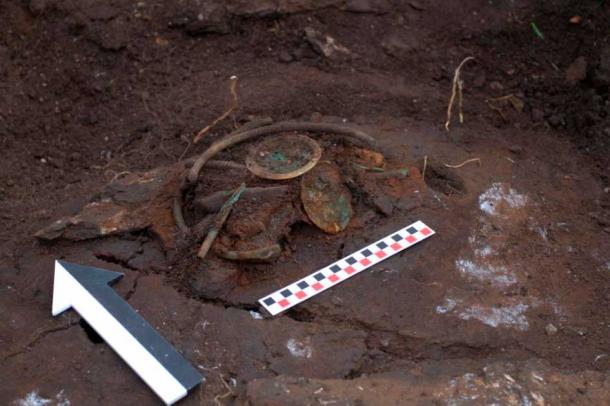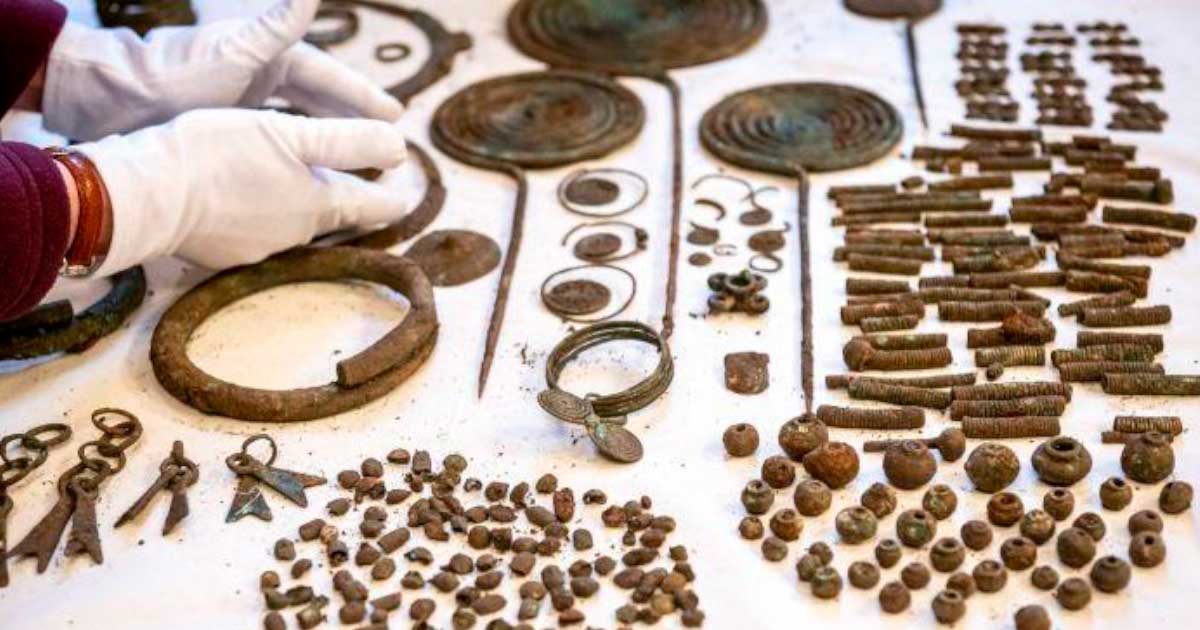Sacrificial Treasure Trove of Bronze Age Artifacts Found in Peat Bog
Researchers in Poland were metal detecting a drained peat bog based on speculation when they unearthed an ancient sacrificial site containing a treasure trove of bronze artifacts dating to the Bronze Age and early Iron Age.
The “stunning discovery” was made in Poland’s Chełmno district by the Kuyavian-Pomeranian Group of History Seekers wielding metal detectors, in a drained peat bog converted to farmland. However, the exact location of the discovery has been kept under wraps for security reasons. Formal excavations have been conducted by the WUOZ in Toruñ and a team from the Institute of Archeology of the Nicolaus Copernicus University in Toruñ, assisted by the Wdecki Landscape Park.
Unearthing the Peat Bog Treasures
Millennia before the first written record of Poland’s Chełmno district in 1065 AD, the Lusatian culture emerged and expanded in the area, marked by an increase in population density and establishment of palisaded settlements.
- Polish Children Unearth Ancient Lusatian Graves In Sandpit
- Family Discovers a Collection of Rare Bronze Age Artifacts in Poland

A reconstruction of a Bronze Age Lusatian culture settlement in Biskupin, 8th century BC (Ludek / CC BY SA 3.0)
Archaeologists uncovered three individual deposits at the recent excavation site, which they describe as “a spectacular treasure trove” of bronze artifacts dating back over 2,500 years to the Lusatian culture. According to a report on Archaeo News the team recovered bronze “necklaces, bracelets, greaves, horse harnesses, and pins with spiral heads.”
- Divers Detect Titanic 700-Year-Old Shipwreck in Vistula River
- Peeking Behind the Veil: Unique and Decorative Burial Urns with Faces in the Pomeranian Culture

These ornate bronze treasures were found in a drained peat bog that is now a field (Tytus Zmijewski)
The researchers said it was “uncommon” to find organic materials at such dig sites, but nevertheless, they also discovered “rare organic raw materials,” including fragments of fabric and rope. As well as finding bronze artifacts and organic materials, the researchers also discovered scattered human bones. These led to the conclusion that the collection of bronze artifacts were deposited during Lusatian culture “sacrificial rituals,” that were performed during the Bronze Age and early Iron Age (12th - 4th century BC).
Peat Bog Treasure Sacrifices to Slow Down Social Change
The Lusatian culture thrived in the later Bronze Age and early Iron Age in what is today Poland, the Czech Republic, Slovakia, eastern Germany and western Ukraine. The culture was particularly widespread in the Oder River and Vistula River basins, and it extended eastwards to the Buh River. However, the researchers said some of the bronze items “were not indigenous to the region,” and it is thought that they came from the Scythian civilization in present-day Ukraine.
The archaeologists have attempted to reconstruct what exactly went on at this sacrificial site, and how it was used? It is suspected that around the same time that the sacrifices were made, nomads began appearing from the Pontic Steppe in central and eastern Europe. It is possible the Lusatian people performed their sacrificial rituals in an attempt to slow down the incomers, who brought with them rapid social changes.

The carefully arranged sacrificial peat bog treasures (Mateusz Sosnowski)
Soldering Society to the Gods
For a richer understanding of how the Lusatian people used bronze to interact with their gods, we might look towards the 2009 discovery of a Late Bronze Age necropolis in Wartosław in west-central Poland. In a mass burial pit, dating to 1100–900 BC, excavators recovered twelve burial urns containing the ashes of at least eight deceased individuals.
Using metallographic, chemical, and petrographic investigations of mortuary goods, the team of scientists determined that the people had been placed in the urns with the tools used in bronze metalworking. These burials not only revealed the ritual and social strategies of the era, but also the organizational procedures and high-social status enjoyed by the ancient Lusatian metalworkers.
Now, with the discovery of this new sacrificial site loaded with bronze sacrificial offerings, in a dried up peat bog, further information will soon be derived about the beliefs, traditions, and social values of this lost Bronze Age culture. After more research, the team hopes that a wider archaeometallurgical and symbolic context will be achieved regarding the ancient Lusatian people who inhabited Poland’s Chełmno district in past times.
Top Image: The spectacular array of treasures uncovered in Polish peat bog are believed to have been sacrifices by the Bronze Age Lusatian culture Source: Tytus Zmijewski
By Ashley Cowie
References
Altunas, L. January 28, 2023. Dozens of unique bronze ornaments discovered in a drained peat bog in Poland. Arkeo News. Available at: https://arkeonews.net/dozens-of-unique-bronze-ornaments-discovered-in-a-drained-peat-bog-in-poland/
Kowalski, L., et al. August 2021. Fire walk with me: Looking through the Lusatian mass grave at Wartosław (Poland, 1100–900 BCE). Journal of Archaeological Science: Reports. Volume 38, August 2021, 103090. Available at: https://www.sciencedirect.com/science/article/pii/S2352409X21003023




















Comments
Where they find bronze objects, it’s always “Bronze Age”. So we know we must question that. Bronze does not rust away like iron. A bronze object can lie in the earth for a hundred thousand years, like through the Ice Age, and be none worse for wear.
Nobody gets paid to tell the truth.